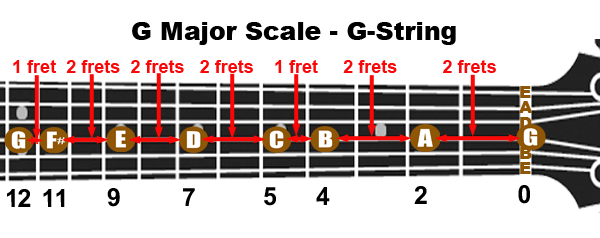Resources for ZoomGuitar Beginners
Resource 5
Keyboard Example
There is a pitch gap of 1 semitone ("half step") between each key.
Two semitones is a tone, and is called a "full step"

On the piano keyboard you can see there are 8 so-called "natural notes" in an octave. These natural notes are the white keys on the piano, and are A,B,C,D,E,F,and G.
The C Major Scale begins on C and moves up, white note by white note, until you reach the next C. The black notes represent the semitone between the white notes. For example, between C and D there is a black note. This is C# (or Db depending on your point of view).
Not all the natural notes (white notes) have a black key between them. There are two instances E-F and B-C where there is no black note. That means that between these notes there is only a semitone. Between all the others there is a full tone (two notes, or two frets on the guitar).
On the guitar, each fret raises the pitch of the string by a semi-tone. So when playing a major scale comparable to the C Major Scale on the piano, the pattern of whole steps (whole tones/2 frets) to half steps (semitones/1 fret) is as follows (where W is a Whole Step and H is a Half Step):
Root - W - W - H - W - W - W - H
On the guitar this means that going up the G string, for example, the G Major Scale would be as indicated here:

In other words, between notes 1 and 2 in the scale there are 2 frets; between 2 and 3 there are two frets, but then between notes 3 and 4 there is only one fret. Continuing on, there are two frets between each note until you get to the 7th note. Then there is only one fret to the 8th note.
This pattern holds for all major scales:
Root - 2 frets - 2 frets - 1 fret - 2 frets - 2 frets - 2 frets - 1 fret
This is important because... when you are on a note and want to go to the next one in the scale you can be sure it is either one or two frets away. And the odds are it is two.
Ode to Joy on the G String
Back to Introductory Resources
